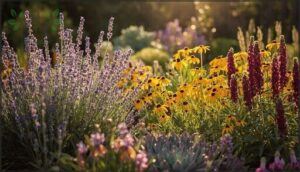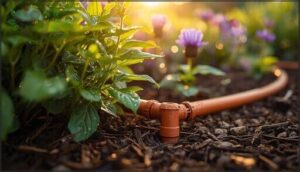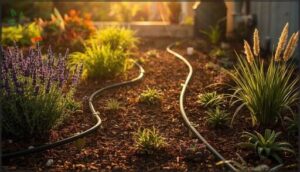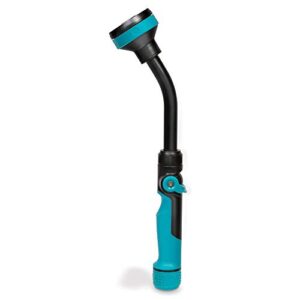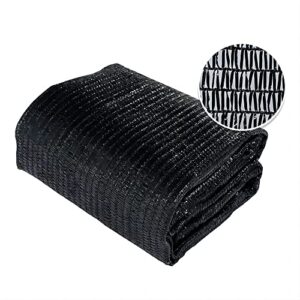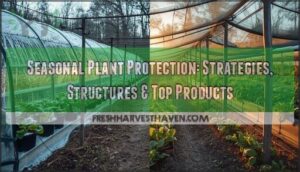This site is supported by our readers. We may earn a commission, at no cost to you, if you purchase through links.
Your summer garden doesn’t have to be a water guzzler to stay green. Sandy soils can lose moisture within hours of watering, while clay soils hold water so tightly that roots can’t access it, leaving you stuck between drought and drowning.
The right drought-tolerant summer garden tips transform these challenges into opportunities, letting you grow a thriving landscape without constant watering or sky-high utility bills. Strategic plant choices, like native perennials that use 50-75% less water than conventional varieties, pair with smart irrigation methods to build gardens that actually get stronger during dry spells.
You’ll save time, money, and resources while creating outdoor spaces that resist heat stress and bounce back faster when rain finally arrives.
Table Of Contents
- Key Takeaways
- Assessing Your Garden’s Drought Risk
- Choosing Drought-Tolerant Plants
- Smart Summer Watering Techniques
- Maximizing Soil Moisture Retention
- Efficient Irrigation Methods for Summer
- Water Conservation Strategies in Hot Weather
- Avoiding Common Summer Watering Mistakes
- Top 8 Tools for Drought-Tolerant Gardens
- 1. Gilmour Flexogen Heavy Duty Garden Hose
- 2. Heavy Duty Swivel Watering Nozzle
- 3. Gilmour Heavy Duty Swivel Nozzle
- 4. Gilmour Swivel Watering Wand Hose Sprayer
- 5. Agfabric Black Shade Cloth Netting Mesh
- 6. Winemana Black Shade Cloth Mesh Tarp
- 7. VIVOSUN Garden Sunblock Shade Cloth
- 8. Neptune’s Harvest Fish and Seaweed Fertilizer
- Designing a Resilient, Water-Wise Landscape
- Frequently Asked Questions (FAQs)
- What is the 3 year rule in gardening?
- Should I water my garden every day in 100 degree weather?
- How to prepare soil for drought tolerant plants?
- How to prevent pests in drought-stressed gardens?
- What are best fertilizers for drought-prone gardens?
- Can drought-tolerant gardens attract pollinators and wildlife?
- How to revive plants after prolonged drought stress?
- What container plants thrive with minimal summer watering?
- How often should I fertilize drought-tolerant plants?
- Can I grow drought-tolerant plants in containers?
- Conclusion
Key Takeaways
- Deep, infrequent watering builds root systems that reach 8+ inches into soil and use half the water of shallow watering, making plants genuinely drought-resistant rather than dependent on constant irrigation.
- Native perennials and drought-adapted plants slash water needs by 50-75% compared to conventional varieties while supporting deeper roots that maintain function even when soil moisture drops.
- Soil amendments with compost boost water-holding capacity by nearly 50%, and a 2-4 inch organic mulch layer cuts evaporation in half while keeping soil temperatures steady through summer heat.
- Morning watering between 5-9 a.m. reduces evaporation losses by 30% compared to midday sessions and prevents the fungal diseases that evening watering can trigger.
Assessing Your Garden’s Drought Risk
Before you start watering differently or redesigning your garden, you need to know what you’re working with. Your soil, sun exposure, and plant health all tell a different story about how your garden responds to heat and dry spells.
Let’s walk through the main factors that determine your garden’s drought risk so you can make smarter decisions this summer.
Identifying Soil Types and Drainage
Before you plant, get to know your soil—it’s the foundation of water retention and soil health. Sandy soils drain fast, losing moisture within hours, while clay holds water but can suffocate roots. Loam offers the sweet spot. A simple jar test reveals your soil texture basics in 48 hours.
Understanding your soil’s composition, including the percentages of sand, silt, and clay, is key to its water-holding capacity. Testing every 3–5 years helps you track soil moisture trends and guides amending soil types for better drought resilience.
Monitoring Sun Exposure and Heat
Soil tells only part of the story—sunlight and soil temperature reveal the rest. Map your garden’s sun hours over a full day, noting which beds get six-plus hours of direct exposure. These hot zones push soil temps up by 20 °C or more compared to shaded spots, accelerating evaporation and triggering heat stress.
Use a soil thermometer to confirm where summer heat hits hardest. Understanding how the sun moves across your yard will help, so be sure to note the cardinal directions.
Recognizing Early Drought Stress in Plants
Heat stress doesn’t wait for plants to wilt. Watch for these early signs that tell you roots aren’t pulling enough soil moisture:
- Leaf Rolling – Edges curl inward to reduce evaporation
- Growth Reduction – New shoots slow or stop extending
- Visual Symptoms – Grayish cast or yellowing appears before browning
- Biochemical Markers – Predawn droop signals dropping water potential
- Yield Impacts – Delayed flowering reduces future harvests
Adjust watering before damage becomes permanent.
Choosing Drought-Tolerant Plants
Once you know what your garden is up against, it’s time to stock it with plants that can handle the heat. The right choices won’t just survive summer—they’ll thrive with far less fuss and water than typical garden favorites.
Here’s a breakdown of the best drought-tolerant options to build a resilient, low-maintenance landscape.
Top Perennials for Dry Conditions
When summer heat turns your garden into a test of endurance, drought-resistant perennials become your best allies. Yarrow varieties thrive with just 0.5 inches of water weekly, while Lavender care remains simple after establishment, needing only 6 to 12 inches annually. Sedum benefits include surviving on 4 inches of rainfall per year. Rudbeckia uses 60% less water than standard perennials, and Penstemon species require under 0.75 inches weekly, making these water-wise plants essential for your drought-tolerant garden.
Low-Water Shrubs and Ornamental Grasses
Your xeriscaping design benefits from selecting native grasses and drought-tolerant shrubs that slash water needs by 60-70% after establishment. Brittlebush, jojoba, and ninebark flourish with minimal irrigation, while ornamental grasses for drought gardens like ‘Breeze’ dwarf mat rush require almost no maintenance.
These water-wise plant choices build soil health through deep root systems, creating a resilient drought-tolerant garden that survives summer’s toughest conditions.
Succulents and Cacti for Summer Gardens
Cacti and succulents anchor your xeriscape garden with their impressive CAM physiology, using one-tenth the water of conventional plants. These drought-resistant plants thrive in coarse, mineral-rich soil—mix two parts sand, one part perlite, one part potting soil. Water in-ground specimens every 10–14 days when temperatures exceed 80°F.
Market trends show succulents dominating water-wise garden sales, reaching $7.6 billion by 2032.
Native Plants for Regional Success
Regional adaptation gives native plants a clear edge in drought-resistant gardens. Research shows they use 50–75% less water than conventional choices while supporting deeper root systems.
You’ll see native species maintain function at lower soil moisture, and they anchor climate resilience by sustaining pollinators that depend on regional flora.
Your plant selection becomes water-wise gardening with purpose.
Smart Summer Watering Techniques
When temperatures soar and rain becomes scarce, how you water matters just as much as what you plant. The right approach can mean the difference between a garden that merely survives and one that actually thrives through the hottest weeks of summer.
Let’s look at three core techniques that will help you water smarter, not harder.
Deep Vs. Frequent Watering Methods
Think of deep watering like teaching your plants to fish—it builds strong, independent root systems. Deep, infrequent irrigation encourages roots to stretch 8 inches or more into the soil, increasing root depth by up to 2 inches compared to shallow techniques.
Deep watering teaches plants to build strong, independent root systems that reach deeper into the soil
This watering frequency uses half the water while improving soil saturation and reducing plant stress.
In contrast, frequent shallow watering restricts roots to the top few inches, creating dependency and water waste.
Best Times of Day to Water
Timing your summer watering isn’t just about convenience—it’s the difference between thriving plants and wasted water. Morning vs evening schedules directly impact evaporation rates, soil moisture, and root hydration. Here’s what you need to know:
- Water between 5:00 and 9:00 a.m. to reduce water evaporation by up to 30%.
- Avoid midday watering—you’ll lose 40-60% to evaporation during peak heat.
- Skip evening sessions to prevent fungal diseases and increased pest pressure from prolonged leaf wetness.
- Let foliage dry quickly in morning sun to minimize disease risk.
- Follow your watering schedule consistently for best root hydration and drought resilience.
These watering techniques protect your plants while conserving precious resources.
Hydrozoning for Efficient Irrigation
Hydrozoning cuts your water use by up to 50% by grouping plants with similar irrigation needs into separate zones. You’ll water thirsty perennials on one schedule, established drought-tolerant plants on another, and lawns separately.
This plant grouping prevents overwatering low-water natives while keeping high-need zones hydrated. Proper zone establishment with efficient irrigation scheduling can slash your water bill while strengthening root systems across your garden.
Maximizing Soil Moisture Retention
Your soil is the foundation of a drought-tolerant garden, and how you treat it makes all the difference in how well your plants hold onto water. When you improve soil structure and protect the surface from sun and wind, you can dramatically reduce how often you need to pull out the hose.
Let’s look at three practical ways to lock moisture into your soil and keep it available to your plants when they need it most.
Amending Soil With Compost and Organics
By enriching your soil with compost and organic matter, you can boost its water-holding capacity by nearly 50%, meaning less frequent watering during summer droughts.
Compost improves soil structure, encourages microbial activity, and creates tiny pore spaces that trap moisture where roots can reach it.
Even a modest addition helps sandy soils hold water longer, strengthening drought resilience across your entire garden.
Applying Mulch for Water Conservation
Once you’ve built a rich soil base, mulching becomes your secret weapon for cutting irrigation needs nearly in half. A two-to-four-inch layer of organic mulch—straw, bark chips, or compost—shields soil from sun and wind, slashing evaporation while keeping soil temperature steady. Material choices matter: finer mulches cover more uniformly, boosting moisture retention and giving roots the consistent hydration they crave.
- Apply mulch depth of 2–4 inches around shrubs and trees
- Cover at least 90% of exposed soil surface for best evaporation reduction
- Choose organic mulch like straw or bark for enhanced water-holding capacity
- Refresh mulching layers yearly to maintain effective soil temperature moderation
- Avoid piling mulch against plant stems to prevent rot
Using Ground Covers to Shade Soil
Beyond mulch, living ground covers deliver a double win: they cool soil by up to 20°F in summer sun while boosting moisture retention around ten percent compared to bare dirt. Fast spreaders like Evolvulus blanket beds in weeks, suppressing weeds and slashing evaporation.
For lasting soil health and weed suppression, pair them with mulching—roots hold water, canopies block heat, and you’ll water less all season.
Efficient Irrigation Methods for Summer
When summer heat spikes and water becomes scarce, the right irrigation system can make all the difference between a thriving garden and a struggling one. You’ll want to move beyond basic sprinklers and adopt methods that deliver water directly where your plants need it most.
Let’s look at three efficient irrigation approaches that conserve water while keeping your drought-tolerant garden healthy through the hottest months.
Drip Irrigation and Soaker Hose Systems
If you want precision watering that cuts water use by up to 60%, drip irrigation and soaker hoses deliver moisture right where roots need it. These efficient irrigation systems operate at low pressure—around 20 psi for drip lines versus 45 psi for sprinklers—saving water and energy while keeping your summer garden thriving.
- Drip irrigation: Uses point-source emitters spaced along tubing, delivering about 1.6 liters per hour per emitter with minimal evaporation
- Soaker hoses: Release water along their entire length, wetting a broader soil band but limited to shorter runs
- Subsurface options: Burying drip lines 6–12 inches deep can reduce seasonal water needs by roughly 10% compared with surface systems
- System maintenance: Check pressure regulation and clean filters regularly to maintain uniform water distribution and prevent emitter clogging
Using Timers and Moisture Sensors
Smart watering tools like controllers and soil moisture sensors can slash outdoor water use by 15% to 40%, saving you thousands of gallons annually.
To see real water savings, you need proper sensor placement in root zones, accurate controller programming based on your climate, and routine checks to avoid manual overrides.
When you set a consistent watering schedule, your soil moisture meter becomes your most reliable guide for efficient irrigation.
Collecting and Using Rainwater
A 1,000-square-foot roof can yield over 600 gallons from just one inch of rain—enough to sustain your drought-resistant gardens through dry spells.
You’ll need proper storage tank sizing based on your catchment area, plus filters for water quality testing before irrigation integration.
Connect multiple rain barrels for larger beds, and direct overflow to rain gardens for runoff reduction.
Harvesting system design paired with drip lines gives you free, chemical-free summer watering that cuts municipal use by 30%.
Water Conservation Strategies in Hot Weather
When temperatures spike and water becomes scarce, smart conservation tactics can make all the difference between a thriving garden and a struggling one. The key is working with your landscape, not against it, by arranging plants strategically and minimizing waste.
Here are three practical ways to stretch every drop of water during the hottest months.
Grouping Plants by Water Needs
Hydrozoning means organizing your drought-tolerant plants into irrigation zones based on their water needs. Creating a zone diagram lets you map low, moderate, and high water categories across your site, which can cut landscape water use by 20–50%.
Install separate timers for each area so you’re not overwatering waterwise plant selections or underwatering thirstier species. Site adjustments improve your hydrozoning for efficient watering.
Creating Shade With Plants and Cloth
Shade can drop soil temperature by 15–20°F and cut evaporation by up to 65%, helping you stretch water between irrigation cycles. Use shade cloth with 80–90% density to shield beds from afternoon sun and prevent sunburn, heat stress, and moisture loss during hot weather gardening.
Combine cloth shade density with plant-based shading—conifers, ornamental grasses, or drought-tolerant shrubs—for overlapping microclimate benefits and stronger plant protection.
Reducing Lawn Areas for Water Savings
Your lawn can drink up half your home’s water, but you can reclaim that. Replacing turf with xeriscape conversion cuts outdoor water use by 50–75%, saving 120 gallons per household daily—plus reducing mowing and upkeep.
Three turf replacement strategies for sustainable landscaping:
- Replace turfgrasses with native ground covers for up to 60% water savings
- Pursue economic incentives like cash-for-grass rebates up to $5 per square foot
- Blend hardscape and lawn replacement alternatives to minimize irrigation zones
Avoiding Common Summer Watering Mistakes
Even the most well-meaning gardeners can sabotage their drought-tolerant efforts with a few common watering mistakes. These errors don’t just waste water—they can actually weaken your plants and leave them less prepared to handle summer heat.
Let’s look at three key mistakes to avoid so your garden stays healthy and resilient all season long.
Overwatering and Shallow Root Growth
You might think more watering is better, but frequent sprinkling creates shallow root systems that can’t handle heat. When you water daily, roots cluster near the surface instead of reaching down for moisture.
This leads to hypoxic soil conditions, accelerates nutrient leaching rates, and encourages fungal disease spread.
Deep, infrequent watering techniques train your roots to dive deeper, building drought-resilient plants.
Ignoring Soil Drainage and Runoff
Poor soil drainage creates waterlogging effects that reduce oxygen by up to 70%, triggering root rot and biomass decline. Clay-heavy soil types worsen this problem, accelerating erosion impacts that strip away nutrients and structural instability in your beds.
Improving soil drainage with compost boosts water absorption and retention, preventing runoff that removes essential topsoil. You’ll protect your plants and landscape by addressing drainage issues before summer heat intensifies stress.
Watering During Peak Heat Hours
Watering during peak heat hours—usually 11 am to 4 pm—wastes up to 50% of water through evaporation before reaching plant roots. Despite myths about leaf scorch, the real problem is inefficiency and plant health impacts.
Recommended schedules call for early morning deep watering between 5 am and 9 am, when soil moisture retention peaks and usage trends show 30–50% better water conservation.
Top 8 Tools for Drought-Tolerant Gardens
You can’t build a drought-tolerant garden with water-saving plants alone—you need the right tools to support them. The equipment you choose determines how efficiently you deliver water, protect plants from heat stress, and maintain healthy soil during dry spells.
Here are eight practical tools that make managing a low-water garden easier and more effective.
1. Gilmour Flexogen Heavy Duty Garden Hose
A reliable hose makes summer watering less of a chore, especially when drought tolerance is your goal. The Gilmour Flexogen Heavy Duty Garden Hose delivers with its 8-layer construction, offering excellent kink resistance and 500 PSI burst strength—far beyond typical home water pressure.
You’ll appreciate the crush-resistant brass couplings and protective collar that prevent frustrating tangles at the spigot. At 100 feet, it reaches distant beds without constant repositioning.
Just note the material safety warnings and check certifications if you’re using it for drinking water applications.
Best For: Homeowners and gardeners who need a durable, kink-resistant hose for regular watering tasks, long runs across the yard, and demanding conditions without the weight of an industrial rubber hose.
- The 8-layer construction and 500 PSI burst strength deliver serious durability and kink resistance that handles dragging over concrete, raised beds, and uneven terrain without early failure.
- Crush-resistant brass couplings and a protective spigot collar prevent the common frustrations of broken connections and tangles right at the faucet.
- At 100 feet, it covers large gardens or lawns without repositioning, and the reinforced design keeps it flexible even in varying temperatures.
- Some users report kinking issues and quality control problems after extended use, including swelling, leaks, or damage upon delivery.
- The connectors can be thin and may require extra effort to tighten properly, which can be inconvenient during setup.
- Material safety warnings (Prop 65) and lack of explicit drinking-water certification on all models mean you need to verify labels if you’re using it for potable water.
2. Heavy Duty Swivel Watering Nozzle
Once you have your hose in place, a heavy duty swivel watering nozzle transforms how you deliver water to drought-stressed beds. The swivel connection reduces kinks by about 70% and cuts hand torque in half, so you won’t wrestle with twisted hoses during those long evening watering sessions.
Metal construction at impact points stands up to drops on concrete, while thumb-control flow adjustment lets you switch from gentle shower to targeted jet without constant squeezing—critical for matching each plant’s water needs.
Best For: Gardeners who need precise, ergonomic control when hand-watering drought-tolerant beds and want to reduce hose kinking during long summer sessions.
- Swivel connection cuts kinks by 70% and reduces hand torque by half, making it easier to maneuver around obstacles without fighting twisted hoses.
- Thumb-control flow adjustment lets you dial from gentle mist to strong jet without constant squeezing, so you can match water delivery to each plant’s needs.
- Metal construction at key stress points withstands drops on hard surfaces and supports multi-year use under normal residential water pressure.
- Some users report leaks at the swivel joint, which can waste water and reduce effectiveness over time.
- Durability varies—a handful of owners experience breakage or malfunction after relatively short periods despite the heavy duty label.
- Priced higher than basic plastic nozzles, which may not justify the cost if you’re only watering occasionally or in a small space.
3. Gilmour Heavy Duty Swivel Nozzle
The Gilmour Heavy Duty Swivel Nozzle earns a 4.3-star rating from users who value its eight clearly labeled spray patterns—from bucket fill to jet—and its one-turn adjustment that lets you adapt quickly as conditions change.
Swivel Connect technology cuts kinks by 70%, while metal construction protects impact points if you drop it during long watering sessions.
Thumb control gives you precise water efficiency without constant squeezing, and the lifetime warranty backs your investment in these smart watering tools for drought-challenged gardens.
Best For: Gardeners who need a durable, versatile nozzle with multiple spray patterns and want to reduce hose kinking during frequent use.
- Swivel Connect technology reduces kinks by 70% and makes the hose easier to maneuver around your yard
- Eight spray patterns handle everything from delicate plant watering to heavy-duty cleaning with a simple one-turn adjustment
- Solid metal construction with lifetime warranty means it can take drops and rough handling over the years
- Some users report leakage problems and mixed experiences with build quality
- Thumb control and swivel connection may loosen or wear out over time
- Parts can snap off if dropped, and you might need to replace washers to keep it working properly
4. Gilmour Swivel Watering Wand Hose Sprayer
Reaching hanging baskets and raised beds often feels like wrestling your hose—that’s where the 36-inch Gilmour Swivel Watering Wand Hose Sprayer earns its place in smart watering tools. Five spray patterns give you versatility from gentle mist to concentrated jet, while the swivel connection cuts kinks by 70% so you’re not fighting twisted hoses mid-task.
Thumb control on the ergonomic wand design lets you adjust flow without hand fatigue during long summer watering sessions.
Though some users report durability issues, the lifetime warranty and 4.5-star rating support its role in efficient irrigation methods.
Best For: Gardeners who need to reach hanging baskets or raised beds without straining, and want versatile spray options for different plant types.
- 36-inch length with swivel connection reduces hose kinks by 70%, making it easier to water hard-to-reach spots
- Five spray patterns let you switch from gentle mist for seedlings to concentrated jet for deep watering
- Thumb control valve adjusts water flow without tiring your hand during long watering sessions
- Some users report durability problems, with units breaking within a few months despite the lifetime warranty
- Leaking issues at the lever and hose connections have been reported by multiple buyers
- Thumb trigger can be stiff initially, requiring a break-in period before it operates smoothly
5. Agfabric Black Shade Cloth Netting Mesh
Summer drought doesn’t have to spell disaster for your tender greens—this 8x12ft black shade cloth blocks 30% of sunlight, dropping plant canopy temps by 8-10°C and cutting evaporation reduction by 40%. The knitted HDPE mesh lets water and air through while protecting plants from sun damage, and installation clips make setup quick.
Gardeners report 30% less summer watering needs and 75% fewer sunscald incidents. Though it may shrink slightly, its UV-blocking performance helps heat-sensitive crops thrive through brutal heat waves.
Best For: Gardeners in hot climates who want to protect heat-sensitive vegetables and cut down on watering without blocking rain or airflow.
- Drops plant temperatures by 8-10°C and reduces water needs by up to 30% during summer heat
- Knitted HDPE construction resists tearing and allows rain and air to pass through while blocking harmful UV rays
- Quick setup with included clips and lightweight design that’s easy to move or store between seasons
- Only blocks 30% of sunlight, which may not be enough for extremely sun-sensitive plants in the hottest regions
- Fabric can shrink when exposed to direct sun over time, potentially reducing coverage area
- Clips may not fit all frame types, and you might need to buy extras for secure installation in windy spots
6. Winemana Black Shade Cloth Mesh Tarp
Managing summer heat just got easier with this 20x10ft shade cloth delivering 40-50% UV reduction that drops soil temps by 8-15°C. The heavy-duty HDPE material weaves in weather resistance and easy installation through grommets every two feet, letting you mount it on fences, pergolas, or greenhouses quickly.
Summer drought pressure eases when you’re cutting daily watering by 25% while protecting plants from sun damage. Growers saw 22% yield increases in heat-sensitive crops like tomatoes, making this shade cloth a practical water conservation tool for resilient summer gardens.
Best For: Gardeners in hot climates who need to protect heat-sensitive crops, reduce water use, and extend growing seasons without complicated setup.
- Cuts daily watering needs by up to 25% while dropping soil temperatures 8-15°C, making summer gardening more manageable
- Boosts yields by 22% for crops like tomatoes and squash by preventing stress, wilting, and bolting during heatwaves
- Easy installation with grommets every 2 feet and durable HDPE construction that lasts multiple seasons without major fading
- Some customers report the material feels thinner than expected and may tear or rip after a few months of heavy use
- Size accuracy issues have been noted, with a few buyers receiving cloths smaller than the advertised dimensions
- May not provide enough shade for plants that need higher light levels for strong photosynthesis and fruiting
7. VIVOSUN Garden Sunblock Shade Cloth
When sun intensity threatens to stall your tomatoes and peppers mid-season, VIVOSUN’s 50-60% shade cloth steps in as your thermal buffer. This 6.5×10ft UV-stabilized polyethylene panel drops leaf temperatures by 1-5°C during heat waves, cutting transpiration rates and extending time between summer watering rounds.
Metal grommets simplify installation over beds or frames, while the breathable knit maintains airflow to prevent humidity buildup. You’re blocking midday intensity without starving drought-tolerant plants of light—a practical move for water conservation when heat stress peaks.
Best For: Gardeners in hot climates who need to protect heat-sensitive vegetables like lettuce and tomatoes from midday sun while cutting down on watering frequency.
- Drops plant temperatures by 1-5°C and blocks 50-60% of sun intensity, reducing heat stress and sunscald on fruits during summer peaks
- UV-stabilized polyethylene construction lasts 5 years outdoors and includes metal grommets for quick setup on beds, frames, or patios
- Breathable knit design maintains airflow while cutting water evaporation and transpiration, so you water less often without trapping humidity
- 50-60% shade level may be too intense for sun-loving crops that thrive in full light, potentially limiting growth in some vegetables
- Only available in black, which absorbs more heat than lighter colors and offers no aesthetic variety for decorative garden spaces
- Needs secure anchoring in windy conditions since the lightweight material can tear or blow away without proper tie-downs
8. Neptune’s Harvest Fish and Seaweed Fertilizer
Fertilizing plants in summer can backfire if you’re already managing soil moisture stress—unless you’re working with an organic fertilizer that feeds roots without forcing excessive water uptake. Neptune’s Harvest delivers a 2-3-1 nutrient profile through cold-processed fish and seaweed, supporting drought-resistant plants by strengthening cell walls and root depth rather than pushing leafy growth.
Its chelated minerals improve soil benefits and microbial life, while application ease via drip lines conserves water. The environmental impact stays minimal—OMRI-certified, no runoff concerns—and a two-inch organic mulch layer extends each feeding cycle.
Best For: Organic gardeners looking for a sustainable fertilizer that strengthens plants during heat and drought without forcing excess growth or risking water stress.
- University trials show 18% higher yields and 12% longer shelf life compared to chemical fertilizers, with plants staying healthier during heat and drought
- OMRI-certified organic formula with chelated nutrients feeds soil microbes and won’t contaminate groundwater or cause runoff issues
- Works in any watering system without clogging—just mix 1 ounce per gallon every 2-3 weeks and you’re set
- Strong fishy smell before dilution can be unpleasant, though most users say it disappears after mixing
- Costs more upfront than basic synthetic options, which might not work for tight budgets
- Needs a good shake before each use and the odor can attract flies if you’re not careful with application
Designing a Resilient, Water-Wise Landscape
A water-wise landscape doesn’t just survive drought—it thrives through smart design choices that cut water use year-round. You can transform thirsty lawn areas, add hardscapes that let water soak in naturally, and build a garden that stays healthy through every season.
These three strategies work together to create a landscape that’s both beautiful and resilient.
Replacing Lawn With Drought-Tolerant Alternatives
Beyond xeriscaping with native perennials, you can replace traditional turf entirely to achieve real water savings. Drought-tolerant alternatives cut outdoor use by up to 75%, making low water landscaping both practical and eco-friendly. Consider these options for your water-wise garden:
- Native ground covers reduce irrigation by 60%
- Creeping thyme or moss phlox for erosion control
- Ornamental grasses need minimal mowing
- Artificial turf eliminates watering completely
- Kurapia saves 60% compared to conventional grass
Creating Permeable Paths and Hardscapes
Hardscaping doesn’t have to block rainfall from reaching your drought-resistant plants. Porous pavers, gravel, and permeable concrete allow water to soak through, replenishing underground reserves and cutting irrigation needs by up to 30%.
Install them with aggregate bases for best infiltration rates, and position paths near planting beds so rainwater passively waters your drought-prone gardens—nature takes care of the watering for you.
Maintaining Year-Round Garden Health
Once your water-wise infrastructure is set, consistent care keeps drought-tolerant plants thriving. Monitor soil moisture weekly—routine testing boosts summer survival by 35%—and watch for wilt or leaf curl to catch stress early. Adjust watering with the seasons, enrich soil with compost annually, and stay alert for pests; monitored gardens see 40% fewer outbreaks, protecting your drought-resistant investment year after year.
Year-Round Garden Maintenance Checklist:
- Check soil moisture weekly during peak heat to prevent dehydration
- Adjust summer watering techniques based on seasonal rainfall patterns
- Refresh mulch layers to maintain consistent soil moisture retention
- Prune and deadhead to reduce plant water demand by 18%
- Monitor for drought stress signs like wilting or dry leaf tips
Frequently Asked Questions (FAQs)
What is the 3 year rule in gardening?
In short, the 3 year rule describes how perennials establish themselves: first year focuses on root development, second year brings moderate growth, and third year delivers full bloom count and improved drought tolerance.
Should I water my garden every day in 100 degree weather?
Not necessarily. Check soil moisture at root depth first—sandy soils dry faster than clay.
Most established plants thrive with deep watering every 2–3 days rather than daily shallow watering, which encourages weak roots.
How to prepare soil for drought tolerant plants?
A gardener transformed their clay-heavy plot by mixing in compost and aged manure, boosting water retention by nearly 30%.
You’ll see healthier roots and less watering when you improve drainage and add organic amendments first.
How to prevent pests in drought-stressed gardens?
Drought-stressed plants attract more pests because weakened defenses make them vulnerable.
You can break this cycle with deep watering, mulch layers, and drought-resistant plants that maintain natural pest control defenses even during dry spells.
What are best fertilizers for drought-prone gardens?
Your best bet? Slow-release fertilizers that match plant uptake, compost amendments to build soil health and water retention, biochar for fertility, seaweed extracts for stress tolerance, and balanced NPK to offset drought losses without excess salts.
Can drought-tolerant gardens attract pollinators and wildlife?
Think of it as building Noah’s ark for insects: pollinator-friendly, drought-resistant gardens become wildlife havens when you include native, drought-tolerant plants with varied bloom times, supporting bees, butterflies, birds, and beneficial insects year-round.
How to revive plants after prolonged drought stress?
Slowly reintroduce water to drought-resistant gardens, starting with deep watering early morning. Roots recover within hours as stomatal conductance normalizes.
Add compost to improve soil moisture retention, helping drought-tolerant plants rebuild stress memory and restore plant health.
What container plants thrive with minimal summer watering?
When water’s tight, succulent varieties like Echeveria and Sedum shine.
Herb options including rosemary, ornamental flowering annuals such as Portulaca, and woody perennials like yucca tolerate extended irrigation frequency—often just weekly watering during summer heat.
How often should I fertilize drought-tolerant plants?
Most drought-tolerant plants need fertilizer only once per year, usually in early spring. Use a slow-release, balanced product at labeled rates. Avoid fertilizing stressed or very dry plants.
Can I grow drought-tolerant plants in containers?
Yes, you can successfully grow drought-resistant plants in containers using well-draining container soil, proper watering frequency, and best practices like deep root development.
Succulents and adapted container plants thrive with strategic container retention techniques for dry sites.
Conclusion
The less water you give your garden, the stronger it becomes. That’s the beauty of drought-tolerant summer garden tips: they train roots to dig deeper, plants to adapt faster, and landscapes to thrive without your constant attention.
You’ve learned to read your soil, choose resilient plants, and water with precision. Now your garden works with nature instead of fighting it, saving resources while delivering color, texture, and life that endures through the hottest months.
- https://extension.psu.edu/heat-and-drought-tolerant-plants/
- https://ucanr.edu/sites/default/files/2018-03/279768.pdf
- https://gardenforwildlife.com/blogs/learning-center/water-wise-wildlife-gardens-what-are-drought-tolerant-native-plants
- https://www.charlottesville.gov/528/Native-Drought-Resistant-Plants
- https://fwbg.org/2025/09/23/look-to-native-plants-for-a-drought-tolerant-ecosystem-friendly-garden/


